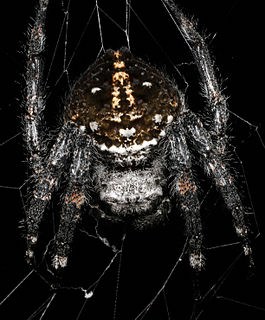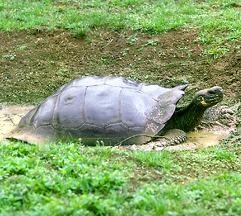
A barnacle is a type of arthropod constituting the subclass Cirripedia in the subphylum Crustacea, and is hence related to crabs and lobsters. Barnacles are exclusively marine, and tend to live in shallow and tidal waters, typically in erosive settings. They are sessile (nonmobile) and most are suspension feeders, but those in infraclass Rhizocephala are highly specialized parasites on crustaceans. They have four nektonic larval stages. Around 1,000 barnacle species are currently known. The name Cirripedia is Latin, meaning "curl-footed". The study of barnacles is called cirripedology.

John Gould was an English ornithologist. He published a number of monographs on birds, illustrated by plates produced by his wife, Elizabeth Gould, and several other artists, including Edward Lear, Henry Constantine Richter, Joseph Wolf and William Matthew Hart. He has been considered the father of bird study in Australia and the Gould League in Australia is named after him. His identification of the birds now nicknamed "Darwin's finches" played a role in the inception of Darwin's theory of evolution by natural selection. Gould's work is referenced in Charles Darwin's book, On the Origin of Species.

Fraser's dolphin or the Sarawak dolphin is a cetacean in the family Delphinidae found in deep waters in the Pacific Ocean and to a lesser extent in the Indian and Atlantic Oceans.

Johannes Japetus Smith Steenstrup FRS(For) HFRSE was a Danish zoologist, biologist, and professor.

Charles Robert Darwin was an English naturalist, geologist and biologist, best known for his contributions to evolutionary biology. His proposition that all species of life have descended from a common ancestor is now widely accepted and considered a fundamental concept in science. In a joint publication with Alfred Russel Wallace, he introduced his scientific theory that this branching pattern of evolution resulted from a process that he called natural selection, in which the struggle for existence has a similar effect to the artificial selection involved in selective breeding. Darwin has been described as one of the most influential figures in human history, and he was honoured by burial in Westminster Abbey.

Anelasma is a monotypic genus of goose barnacles that live as parasites on various shark hosts.

Sir Richard Owen was an English biologist, comparative anatomist and paleontologist. Owen is generally considered to have been an outstanding naturalist with a remarkable gift for interpreting fossils.

Puijila darwini is an extinct species of stem-pinniped which lived during the Miocene epoch about 21 to 24 million years ago. Approximately a metre in length, the animal possessed only minimal physical adaptations for swimming. Unlike modern pinnipeds, it did not have flippers and its overall form was otter-like, albeit more specialized; its skull and teeth are the features that most clearly indicate that it is a seal.
Darwini, a New Latin adjective that commonly refers to Charles Darwin, may refer to:

Commemoration of Charles Darwin began with geographical features named after Darwin while he was still on the Beagle survey voyage, continued after his return with the naming of species he had collected, and extended further with his increasing fame. Many geographical features, species and institutions bear his name. Interest in his work has led to scholarship and publications, nicknamed the Darwin Industry, and his life is remembered in fiction, film and TV productions as well as in numerous biographies. Darwin Day has become an annual event, and in 2009 there were worldwide celebrations to mark the bicentenary of Darwin's birth and the 150th anniversary of the publication of On the Origin of Species.

Darwin's bark spider is an orb-weaver spider that produces the largest known orb webs, ranging from 900 to 28,000 square centimetres, with bridge lines spanning up to 25 metres (82 ft). The spider was discovered in Madagascar in the Andasibe-Mantadia National Park in 2009. Its silk is the toughest biological material ever studied. Its tensile strength is 1.6 GPa. The species was named in honour of the naturalist Charles Darwin, with the description being prepared precisely 150 years after the publication of The Origin of Species, on 24 November 2009.
Megabalanus stultus is a species of barnacle first described by Charles Darwin in 1854. It lives on fire corals of the genus Millepora in the Atlantic Ocean from Florida to southern Brazil.
Calantica is a genus of barnacles in the family Calanticidae, containing the following species:

Megabalanus coccopoma, the titan acorn barnacle, is a tropical species of barnacle first described by Charles Darwin in 1854. Its native range is the Pacific coasts of South and Central America but it is extending its range to other parts of the world.

Catomerus is a monotypic genus of intertidal/shallow water acorn barnacle that is found in warm temperate waters of Australia. The genus and species is very easily identified by whorls of small plates surrounding the base of the primary shell wall; no other shoreline barnacle species in the Southern Hemisphere has that feature. This species is considered to be a relic, as these plates are found only in primitive living lineages of acorn barnacles or in older fossil species. The fact that this is an intertidal species is unusual, because living primitive relic species are often found in more isolated habitats such as deep ocean basins and abyssal hydrothermal vents.

Evolution Day is a celebration to commemorate the anniversary of the initial publication of On the Origin of Species by Charles Darwin on 24 November 1859. Such celebrations have been held for over a century, but the specific term "Evolution Day" for the anniversary appears to be a neologism which was coined prior to 1997. By highlighting Darwin's contributions to science, the day's events are used to educate about evolutionary biology. It is similar to the better-known Darwin Day, held on the anniversary of his birth. It is unrelated to the secularization campaign by the Giordano Bruno Foundation to have the German public holiday of Ascension Day renamed to "Evolutionstag".
Darwin's mudskipper is a relatively newly discovered mudskipper in 2004, so little is known about it. It is a brackish water ray-finned fish found in Australia along mud banks never far from mangrove trees. It is in the goby family Gobiidae. It is named after Charles Darwin because the holotype was collected in Darwin Harbour. Its greatest distinguishing characteristic from other mudskippers is its greatly reduced first dorsal fin in both sexes.
Cyrtobill is a genus of Australian orb-weaver spiders containing the single species, Cyrtobill darwini. It was first described by V. W. Framenau & N. Scharff in 2009, and has only been found in Australia.

The Santiago Island giant tortoise, also known commonly as the Santiago giant tortoise and the James Island tortoise, is a subspecies of Galápagos tortoise in the family Testudinidae. The subspecies is endemic to Santiago Island in the Galápagos.
Ibla quadrivalvis is a species of barnacle in the Iblidae family. The common name for this species is hairy stalked barnacle.













